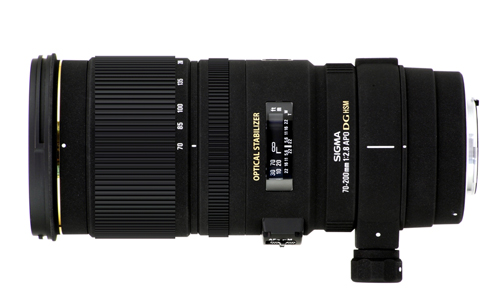Sigma 70-200mm f/2.8 EX DG OS HSM
 |
| Sigma have a long history of producing decent lenses in this range. In this review, Gary Wolstenholme takes a look at their latest optically stabilised version. |
This popular focal range has long been covered by Sigma and their lenses in this range have received regular updates over time. Currently this optically stabilised version sits at the top of Sigma's range and costs around £1200 as a result. For your money, you get fast silent Hyper Sonic focusing and an optical stabiliser. Sigma's non-stabilised version is also still available and can be picked up for around £650.
Tamron are currently the only other third party manufacturer offering an f/2.8 lens in this range. Their 70-200mm f/2.8 SP AF lacks the optical stabilisation and fast silent focusing motor of this Sigma, but it can be picked up for around £620.
Canon currently offer two lenses in this range with an f/2.8 aperture. The more expensive of the two is their image stabilised EF 70-200mm f/2.8L IS USM II, which costs around £1670. The cheaper lens lacks image stabilisation and costs around £900. Both lenses sport rugged, professional build quality, sealing against dust and moisture and fast, silent ultrasonic focusing motors. Canon users also have the luxury of two f/4 aperture lenses in this range to choose from, which make a good compact, lightweight alternative if you don't really need the light gathering ability the f/2.8 aperture affords you. Their image stabilised EF 70-200mm f/4 IS USM costs around £840 and the non-image stabilised version costs only £480.
Nikon currently only offer one lens covering this range. Their 70-200mm AF-S f/2.8G ED VR II costs around £1620 and offers professional weather sealed construction, vibration reduction and fast silent wave focusing.
Sony's 70-200mm f/2.8G SSM lens can be picked up for around £1640 and also offers fast silent focusing and weather sealed construction, but no optical image stabilisation. Whether this is necessary on a Sony camera is debatable, as image stabilisation is built into the body on Sony DSLRs.
Pentax do not currently offer a 70-200mm f/2.8 lens, so offerings from third party manufacturers such as this may be of particular interest to Pentax camera owners.
Sigma 70-200mm f/2.8 EX DG OS HSM: Handling and features
Weighing 1.4kg, this Sigma lens is certainly not lightweight, saying that it is lighter than equivalents from both Nikon and Canon, which is noticeable when using the lens for long periods. The lens balances nicely on the D700 used for testing, with or without the MB-D10 attached. Much of the lens barrel is constructed from high quality plastics, and some parts are finished in a matt black powder coated effect, such as the zoom and focus rings and the removable tripod collar. From a completely subjective point of view, I'm not sure about the two tone effect. It leaves the non-powder coated parts looking unfinished in my opinion, but still the overall fit and finish of the lens is good.
The control layout has changed from previous Sigma 70-200mm lenses, with the zoom ring being placed out near the filter thread and the focus control being placed just behind that, closer to the camera body. I do like the new layout as I find this arrangement easier to support when using the lens for long periods. Zooming and focus are performed internally, so the lens does not extend at all, and the filter thread does not rotate, making this lens ideal for use with polarising and neutral density graduated filters. Switches for autofocus and optical stabilisation are located to the left of the lens barrel and protrude by about 5mm from the main body of the lens. This made using the lens in portrait orientation a little uncomfortable, as the block of switches digs into the palm of my hand as I support the weight of the camera and lens.
Autofocus is powered by a hyper sonic motor, which is fast, silent and accurate during testing. The focusing speed should easily be adequate for most sports and wildlife uses. This lens is amongst the first Sigma to include FLD glass in its optical formulation. This exotic glass promises to give performance equal to fluorite glass, so it will be interesting to see how the lens performs, especially with control of chromatic aberrations.
Sigma's optical Stabiliser promises to allow sharp shots to be taken hand held at shutter speeds up to four stops lower than would be possible without any help. At 200mm I am able to take shots that are sharp most of the time hand held at 1/25sec, and about a third of the time at 1/13sec, which is pretty good performance.
Sigma 70-200mm f/2.8 EX DG OS HSM: Performance
This lens produced a mixed bag of results during testing, and seems to perform at its best across the frame at 200mm.
At 70mm and f/2.8 the centre sharpness will satisfy most, but may disappoint the more discerning photographer, who wishes to produce large prints at this aperture. Towards the edges the sharpness is only just better than what I would classify as poor. Stopping the lens down improves matters at this focal length, as it does throughout the zoom, although the difference is more noticeable at 70mm. At f/4 the sharpness in the centre reaches excellent levels but the quality towards the edges lags behind somewhat. I tend to find the quality towards the edges is less critical on telephoto zooms like this, as your subject will often be near the middle and isolated from the background by the shallow depth of field. Peak quality across the frame is achieved between f/11 and f/16, where the sharpness in the centre is excellent and the quality towards the edges is very good.
Zooming to 135mm lifts the sharpness of the lens. At f/2.8 the resolution in the centre is already very good and the quality towards the edges is fair. Peak quality across the frame is achieved at f/11 for this focal length. Here the sharpness across the frame is excellent.
Finally, at 200mm the sharpness produced in the centre at f/2.8 is already very good, and the quality towards the edges isn't too far behind. Peak quality across the frame is achieved at f/11 where the lens produces excellent sharpness across the frame.
It seems Sigma's exotic FLD glass has done the trick by keeping chromatic aberrations to an absolute minimum. In fact the figures recorded by Imatest were so low, they are barely worth talking about in detail. Needless to say, you should not notice any coloured fringing in images taken in real world shooting scenarios.
Falloff of illumination towards the corners is typical for a lens of this type. At 70mm and f/2.8 the corners are 2.03 stops darker than the image centre and the lens needs to be stopped down to f/5.6 for visually uniform illumination. This behaviour remains constant throughout the zoom with the corners being 2.07stops darker than the image centre at 200mm.
At 70mm Imatest recorded 2.12% barrel distortion, which is only mild and should only become an issue in super-critical applications. At 200mm 1.41% pincushion distortion has taken place of the barrelling at 70mm. This level is also very mild and shouldn't be an issue for most. If you need your lines absolutely straight, you'll be glad to hear that the distortion pattern is uniform across the frame, which should make corrections in image editing software easy.
This lens is very resistant to flare and ghosting, thanks in part to the excellent and deep, petal shaped hood. Just in case you're using the lens on a crop sensor camera, or with a 1.4x teleconverter Sigma also provide an extension piece fro the hood, which makes it a couple of centimetres deeper. With light sources in the frame, the lens is still pretty resistant to flare, but I did notice the contrast drop off quite noticeably under these conditions.
 | DxOMark provides objective, independent, RAW-based image quality performance data for lenses and digital cameras to help you select the best equipment to meet your photographic needs. Visit the DxOMark website for tests performed on the Sigma 70-200mm f/2.8 EX DG OS HSM. |
Sigma 70-200mm f/2.8 EX DG OS HSM: Verdict
During testing this Sigma lens has proved itself quite capable of producing excellent results. For the most part, the sharpness in the centre is very good, or even excellent. Unfortunately its Achilles heel is the performance wide open at 70mm, where it is a bit lacklustre for a lens costing £1200.
Sigma's optical stabiliser is certainly capable and is about as effective as the system found in marque lenses. This adds to the feeling of good value this lens provides, especially as it's around £400 cheaper than the marque competition.
Sigma 70-200mm f/2.8 EX DG OS HSM: Pros
 Excellent centre sharpness at most focal lengths and apertures
Excellent centre sharpness at most focal lengths and apertures Very low CA levels
Very low CA levels Fast AF
Fast AF Optical Stabiliser
Optical Stabiliser Decent build quality
Decent build qualitySigma 70-200mm f/2.8 EX DG OS HSM: Cons
 Lacklustre resolution performance at 70mm and f/2.8
Lacklustre resolution performance at 70mm and f/2.8| FEATURES |  |
| HANDLING |  |
| PERFORMANCE |  |
| VALUE FOR MONEY |  |
| OVERALL |  |
Sigma 70-200mm f/2.8 EX DG OS HSM: Lens specification
| Price | £1,200.00 |
| Contact | www.sigma-imaging-uk.com |
| Filter size | 77mm |
| Format | Full Frame |
| Construction | 22 elements in 17 groups |
| Angle-of-view | 34.3 - 12.3 degrees |
| 35mm equivalent focal length (on APS-C body) | 105-300mm |
| Internal focusing | Yes |
| Image stabilisation | Yes |
| Minimum focus | 1.4m |
| Maximum aperture | f/2.8 |
| Minimum aperture | f/22 |
| Weight | 1430g |
| Size | 86.4 x 197mm |
| In the box | Lens Case, Lens Hood |
The Sigma 70-200mm f/2.8 EX DG OS HSM costs around £1200 and is available from Warehouse Express here:
Sigma 70-200mm f/2.8 EX DG OS HSM for Canon
Sigma 70-200mm f/2.8 EX DG OS HSM for Nikon
Sigma 70-200mm f/2.8 EX DG OS HSM for Sigma
Sigma 70-200mm f/2.8 EX DG OS HSM for Sony
Sigma 70-200mm f/2.8 EX DG OS HSM for Pentax
Add your message
Login required
Please login here or if you've not registered, you can register here. Registering is safe, quick and free.
Please login here or if you've not registered, you can register here. Registering is safe, quick and free.
photodo Stats
1102 lenses
428 MTF tests
74 in-depth photodo reviews
100+ users join each day
Help the lens community by reviewing or rating a lens today via our lens search
428 MTF tests
74 in-depth photodo reviews
100+ users join each day
Help the lens community by reviewing or rating a lens today via our lens search
Latest Lens Reviews
- Chinon 28mm f/2.8 Vintage Lens Review
- Canon EF 70-200mm f/4L IS II USM Lens Review
- Samyang AF 85mm f/1.4 EF Review
- Sigma 70mm f/2.8 DG Macro Art Review
- Samyang AF 24mm f/2.8 FE Review
- Meike 50mm f/1.7 Review
- Tamron 70-210mm f/4 Di VC USD Review
- Lensbaby Burnside 35mm f/2.8 Review
- Asahi Super Takumar 50mm f/1.4 Review
- Asahi Super-Multi-Coated Takumar 135mm f/3.5 Review








